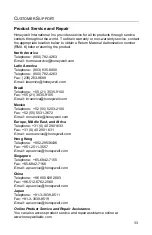
27
R
EGULATORY
R
EQUIREMENTS
AND
W
ARNINGS
Canada
Laser Safety
The Radiation Protection Bureau currently accepts products meeting the FDA
standards in Canada. For more information contact:
Radiation Protection Bureau
775 Brookfield Road
Ottawa, Ontario K1A 1C1
EMC
The IS4125 has been tested to meet Class B EMC Standards. The integrator is
responsible to maintain proper EMC techniques to maintain this performance
level.
Products meeting FCC 47 CFR Part 15 will meet Industry Canada interference-
causing equipment standard for digital apparatus. Additional testing is not
required.
A written notice indicating compliance must accompany the apparatus to the end
user. The notice shall be in the form of a label that is affixed to the apparatus.
The notice may be in the form of a statement included in the user’s manual if,
because of insufficient space or other restrictions, it is not feasible to affix a label
to the apparatus.
Warnings
United States
WARNING:
IS4110 scan engines do not include control circuitry and therefore do not incorporate a
laser beam timeout. This feature is necessary for compliance to CDRH Class II and /or
IEC Class 2 unless laser product modifications that change the requirement are made.
German
WARNUNG:
Die Scanner IS4110 verfügen über keinen Steuerungsschaltkreis und daher auch nicht
über einen Timeout des Laserstrahls. Diese Eigenschaft ist jedoch nötig zur Konformität
mit den Normen CDRH Class II und/oder IEC Class 2, außer es werdenn Modifikationen
des Laserprodukts vorgenommen, die zugleich die Anforderungen erfüllen.
French
AVERTISSEMENT:
Comme les scanner IS4110 ne sont pas équipés d'un circuit de commande, il n'y a pas
de temps imparti pour le faisceau du laser. La conformité aux normes CDRH ClassII
et/ou IEC Class 2 exige cependant cette propriété, sauf si les produits laser sont
modifiés de facon à ce que ces exigences shangent aussi.
Italian
ATTENZIONE!
Gli scanner IS4110 non dispongono di un circuito di regolazione e quindi neanche di un
timeout del raggio laser. Tuttavia questa caratteristica è necessaria ai fini della
conformità con le norme CDRH Class II e/o IEC Class 2, a meno che non vengano
effettuate modifiche del prodotto laser che mutino a loro volta I requisiti da soddisfare.










































